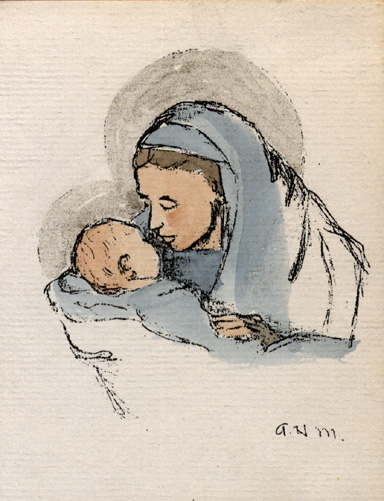The Angelus
The Angelus
About the Angelus - History - Angelus Bells - Regina Caeli/Salve Regina

[Madonna and Child - Watercolor by Alice Mankowski]
V: The Angel of the Lord declared unto Mary
R: And she conceived by the Holy Ghost.
V: Hail Mary, full of grace: The Lord is with thee. Blessed art thou among women and blessed is the fruit of thy womb, Jesus.
R: Holy Mary, Mother of God: Pray for us sinners now and
at the hour of our death. Amen.
V: Behold, the handmaid of the Lord.
R: Be it done unto me according to thy word.
V: Hail Mary ...
R: Holy Mary ...
V: And the Word was made flesh
R: And dwelt among us.
V: Hail Mary ...
R: Holy Mary ...
V: Pray for us, O holy Mother of God,
R: That we may be made worthy of the promises of Christ.
V: Let us pray.
All: Pour forth, we beseech thee, O Lord, thy grace unto our hearts, that we, to whom the Incarnation of Christ, thy Son, was made known by the message of an Angel, may by His Passion and Cross be brought to the glory of His Resurrection, through the same Christ, our Lord, Amen.
Blessing before meals: Bless us, O Lord, and these thy gifts, which we are about to receive from thy bounty, through Christ, our Lord, Amen.
Latin:
Angelus Domini
Ángelus Dómini nuntiávit Maríæ.
Et concépit de Spíritu Sancto.
Ave, María...
Ecce ancílla Dómini.
Fiat mihi secúndum verbum tuum.
Ave, María...
Et Verbum caro factum est.
Et habitávit in nobis.
Ave, María...
Ora pro nobis, sancta Dei génetrix.
Ut digni efficiámur promissiónibus Christi.
Orémus.
Grátiam tuam, quæsumus,
Dómine, méntibus nostris infúnde;
ut qui, Ángelo nuntiánte,
Christi Fílii tui incarnatiónem cognóvimus,
per passiónem eius et crucem,
ad resurrectiónis glóriam perducámur.
Per eúndem Christum Dóminum nostrum. Amen.
Glória Patri...
Angelus Domini -- Excerpts From Directory on Popular Piety and the Liturgy, Principles and Guidelines on the Vatican Website.
195. The Angelus Domini is the traditional form used by the faithful to commemorate the holy annunciation of the angel Gabriel to Mary. It is used three times daily: at dawn, mid-day and at dusk. It is a recollection of the salvific event in which the Word became flesh in the womb of the Virgin Mary, through the power of the Holy Spirit in accordance with the salvific plan of the Father.
The recitation of the Angelus is deeply rooted in the piety of the Christian faithful, and strengthened by the example of the Roman Pontiffs. In some places changed social conditions hinder its recitation, but in many other parts every effort should be made to maintain and promote this pious custom and at least the recitation of three Aves. The Angelus "over the centuries has conserved its value and freshness with its simple structure, biblical character [...] quasi liturgical rhythm by which the various time of the day are sanctified, and by its openness to the Paschal Mystery" (231).
It is therefore "desirable that on some occasions, especially in religious communities, in shrines dedicated to the Blessed Virgin, and at meetings or conventions, the Angelus be solemnly recited by singing the Ave Maria, proclaiming the Gospel of the Annunciation" (232) and by the ringing of bells.
The Angelus is a short devotion in honor of the Incarnation, repeated three times each day, morning, noon, and evening, at the sound of the bell. It consists essentially in the triple repetition of the "Hail Mary", to which in later times have been added three introductory versicles, and a concluding versicle and prayer.
During the Easter season, the Regina Caeli (Queen of Heaven) replaces the usual arrangement of the Angelus prayers. The Salve Regina (Hail, Holy Queen) is often recited as the concluding prayer.
The devotion derives its name from the first word of the three versicles, Angelus Domini nuntiavit Mariæ (The angel of the Lord declared unto Mary).
The origins of the Angelus are somewhat obscure, but it seems clear they are rooted in monastic prayers of the hours, and even in its earliest form included the three "Hail Marys". Originally the Angelus prayers were said at Compline (night prayer), and over the years mid-day and morning hours were added. By the early seventeenth century the formula of prayers exactly as we know it today was complete.
The triple "Hail Mary" was closely associated with the ringing of a bell, a practice apparently derived from the monastic tradition of Compline. The three interrupted peals of the Ave bell probably served as an introduction to the continuous tolling of the curfew that preceded Matins (morning prayer).
The manner of ringing the Angelus -- the triple stroke repeated three times, with a pause between each set of three (a total of nine strokes), which might be followed by a longer peal as at curfew -- seems to have been in place from the very beginning. In the fifteenth-century constitutions of Syon monastery, it is directed that the lay brother "shall toll the Ave bell nine strokes at three times, keeping the space of one Pater and Ave between each three tollings".
Bells dedicated to the Angelus can be found throughout Europe -- inscriptions include: Ave Maria and O Rex Gloriæ Veni Cum Pace (O King of Glory, Come with Peace). A number of European Angelus bells are dedicated to Saint Gabriel, with inscriptions including: Dulcis instar mellis campana vecor Gabrielis (I am sweet as honey, and am called Gabriel's bell) and Missus vero pie Gabriel fert læta Mariæ (Gabriel the messenger bears joyous tidings to holy Mary.)
A fifteenth-century bell at Erfert bears the words: Cum ter reboo, pie Christiferam ter aveto (When I ring thrice, thrice devoutly greet the Mother of Christ). Though the practice of saying the Angelus declined in the latter half of the twentieth century, many parishes continue the tradition of ringing the Angelus bells, traditionally at 6:00 a.m., noon and 6:00 p.m.